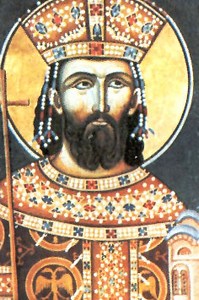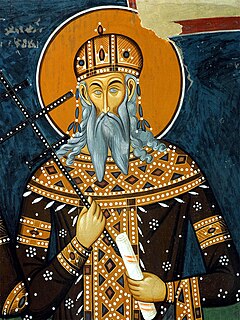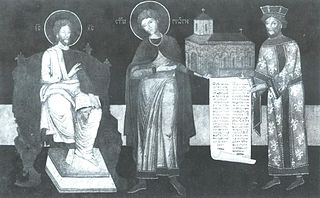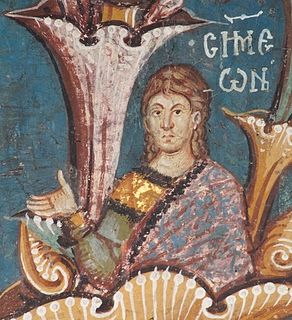 W
WNikola Altomanović was a 14th-century Serbian župan of the House of Vojinović. He ruled the areas from Rudnik, over Polimlje, Podrinje, east Herzegovina with Trebinje, reaching as far as Konavle and Dračevica, neighboring the Republic of Dubrovnik. He was defeated and blinded in Užice in 1373 by a coalition of his Serbian and Bosnian royals neighbors supported by the king of Hungary.
 W
WBogdan, was a Serbian magnate (velikaš) in the service of Despot Stefan Lazarević, with the title of protovestijar. He was the ktetor (donator) of Kalenić monastery, built in 1407–13. He is mentioned in 1426 alongside veliki vojvoda Radoslav, čelnik Radič and logotet Voihna. He had a brother, Petar. His wife was named Milica.
 W
WGradislav Borilović was a Serbian magnate in the service of Stefan Uroš III Dečanski and Stefan Dušan, having the titles of vojvoda (general), kaznac, and tepčija. Gradislav led the Serbian army that fought the Ottoman emirate at the Battle of Demotika in October 1352. The battle was fought between the allies of the two rival Byzantine Emperors, John V Palaiologos and John VI Kantakouzenos, and it was the first major battle of the Ottomans on European soil, which ended in a Serbian defeat. Greek sources spoke of Gradislav as "truly one of the most respectable among the Serbs".
 W
WVuk Branković was a Serbian medieval nobleman who, during the Fall of the Serbian Empire, inherited a province that extended over present-day southern and southwestern Serbia, entire Kosovo, the northern part of present day Republic of North Macedonia, and northern Montenegro. His fief was known as Oblast Brankovića or simply as Vukova zemlja, which he held with the title of gospodin, under Prince Lazar of Serbia. After the Battle of Kosovo (1389), Vuk was briefly the de facto most powerful Serbian lord.
 W
WDejan was a Serbian magnate who served Emperor Stefan Dušan as sevastokrator, and Emperor Uroš V as despot. He was married to Emperor Dušan's sister Teodora, and possessed a large province in the Kumanovo region, east of Skopska Crna Gora. It initially included the old župe (counties) of Žegligovo and Preševo. Uroš V later gave Dejan the Upper Struma river with Velbužd (Kyustendil). Dejan built the Zemen Monastery, among others, and reconstructed several church buildings throughout his province.
 W
WHrelja (Bulgarian: Хрельо, Hrelyo;, also known as Stefan Dragovol or Hrelja Ohmućević was a 14th-century semi-independent feudal lord in the region of northeastern Macedonia and the Rila mountains who served medieval Serbian kings Stefan Milutin, Stefan Dečanski and Stefan Dušan. He is known for reconstructing the Rila Monastery, Bulgaria's largest monastery, in 1334–1335.
 W
WPrince Lazar Hrebeljanović was a medieval Serbian ruler who created the largest and most powerful state on the territory of the disintegrated Serbian Empire. Lazar's state, referred to by historians as Moravian Serbia, comprised the basins of the Great Morava, West Morava, and South Morava rivers. Lazar ruled Moravian Serbia from 1373 until his death in 1389. He sought to resurrect the Serbian Empire and place himself at its helm, claiming to be the direct successor of the Nemanjić dynasty, which went extinct in 1371 after ruling over Serbia for two centuries. Lazar's programme had the full support of the Serbian Orthodox Church, but the Serbian nobility did not recognize him as their supreme ruler. He is often referred to as Tsar Lazar Hrebeljanović ; however, he only held the title of prince.
 W
WBranko was a Serbian magnate who served king and emperor Stefan Dušan, and emperor Stefan Uroš V, with the titles of sluga and later sevastokrator. A member of an old and respectable family, possibly descending from the Serbian dynasty itself, Branko began his royal service in the nearest circle of the ruler. After the elevation of the Serbian state to an empire (1346), Branko received the second-highest court title, sevastokrator, usually given to relatives. He governed the Ohrid region. Branko had three sons and a daughter, of whom Vuk Branković would become an important person in the period of the Fall of the Serbian Empire.
 W
WVukašin Mrnjavčević was King of Serbia as the co-ruler of Stefan Uroš V from 1365 to 1371. Principal domains of king Vukašin and his family were located in southern parts of medieval Serbia and northwestern parts of the historical region of Macedonia.
 W
WJovan Oliver Grčinić was a magnate of the Serbian Emperor Dušan the Mighty, holding the titles of sebastokrator and despotes, and the rank of "great voivode", showing his prominence and status as one of the most important nobles of Dušan. Oliver supported Dušan in the succession war against his father, and was one of the supreme generals in the southern military expeditions. His province included Ovče Pole and the left bank of the Vardar. After the death of Emperor Dušan, there are no more mentions of Oliver. During the fall of the Serbian Empire, his lands were held by the Dejanovići.
 W
WVlatko Paskačić was a 14th-century Serbian feudal lord (sebastokrator) of Slavište region around Kriva Palanka under the Mrnjavčevići (1366-1395), in modern Republic of Macedonia.
 W
WPreljub was a Serbian magnate who served Emperor Stefan Dušan as vojvoda (general). He participated in the southern conquests and held Thessaly with the rank of caesar (kesar) in 1348–56. His son Thomas Preljubović was Despot of Epirus in 1366–84.
 W
WRadič was a Serbian nobleman that had the title of Grand Čelnik, the highest dignitary after the Serbian monarch. He began his service under Prince, later Despot, Stefan Lazarević as čelnik, then was elevated to Grand Čelnik during the rule of Despot Đurađ Branković. He was very wealthy, and held the silver mines in Novo Brdo of the Serbian Despotate. Radič founded and renovated several churches and monasteries which still exist, including the notable Vraćevšnica and Kastamonitou. He took monastic vows and became a monk in Kastamonitou where he spent his last years.
 W
WSimeon Uroš, nicknamed Siniša (Синиша), was a self-proclaimed Emperor of Serbs and Greeks, from 1356 to 1370. He was son of Serbian King Stefan Dečanski and Byzantine Princess Maria Palaiologina. Initially, he was awarded the title of despot in 1346, and appointed governor of southern Epirus and Acarnania in 1347 by his half-brother, Serbian Emperor Stefan Dušan. After Dušan's death in 1355, the Serbian throne passed to Dušan's son Stefan Uroš V, but despot Simeon decided to seize the opportunity in order to impose himself as co-ruler and lord of all southern provinces of the Serbian Empire. That led him to conflict with his nephew in 1356, when Simeon started to expand his control in southern regions of the Empire, trying to take Thessaly and Macedonia. He proclaimed himself Emperor of the Serbs and Greeks, creating a separate state, centered in regions of Thessaly and Epirus, where he ruled until his death in 1370. He was succeeded by his son Jovan Uroš.
 W
WVukdrag was a Serbian nobleman who served King Stefan Dečanski as čelnik. He was a magnate in the Rudnik mountain area, who founded the Raška style church in Dići, below the Rudnik, before 1327, most likely as a family temple. He must have had one of the important gubernatorial functions in the Rudnik oblast (province) during the reigns of kings Stefan Milutin and Stefan Dečanski. Unknown in historical sources, he was buried in his church, where his gravestone inscription tells that he died on 8 May 1327, on the Feast of the Ascension (Spasovdan), and that he had taken monastic vows as Nikola (Никола) and [once] held the title of čelnik. It is unclear if there was one or several individuals with that title at the court at that time; Đuraš Ilijić was mentioned with the title in 1326, and Gradislav Vojšić, for the second time, in 1327. He was buried in a special tomb inside the church, and his gravestone was set by his wife Vladislava. The unearthing of the gravestone gave new facts in the understanding of the territorial contours of the Serbian state north of Rudnik at the end of the 13th- and beginning of 14th century. The largest medieval necropolis in Serbia was unearthed around the church, with flat gravestones belonging to the oldest phase of the Stećak culture.
 W
WVojislav Vojinović was a 14th-century Serbian nobleman, and one of the leading members of Serbian noble House of Vojinović. He held prominent offices during the reigns of Serbian Emperors Stefan Dušan and Stefan Uroš. His father Vojin was governor of the region of Hum, while Vojislav held several positions, from 1349 to 1363. After 1355, he became the most influential noble in northwestern parts of the Serbian Empire, controlling frontier regions between the Adriatic coast and river Drina, including Konavli, Trebinje, Popovo Polje, Gacko and Užice.